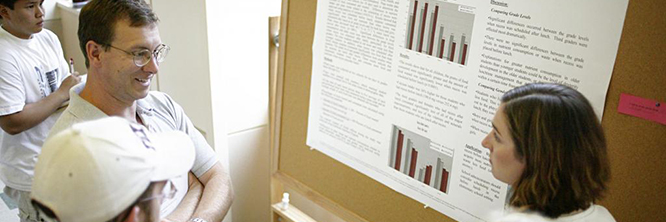Observing Transiting Exoplanets with the Central Washington University 0.6-meter Research Telescope
Document Type
Poster
Event Website
https://source2022.sched.com/
Start Date
16-5-2022
End Date
16-5-2022
Keywords
Physics, Astronomy, Exoplanets
Abstract
Using the 0.6-meter research telescope at Central Washington University (CWU), six confirmed transiting exoplanets were observed to test whether exoplanet transits are detectable with the CWU telescope. Observations were held between 16 June and 22 July 2021. The targets of observation were the exoplanets orbiting CoRoT-2 (1.74 day orbital period, 0.0868 day transit duration), HAT-P-18 (5.5 day orbital period, 2.7 hour transit duration), HAT-P-23 (1.2 day orbital period, 2.2 hour day transit duration), HAT-P-67 (4.81 day orbital period, 6.9 hour transit duration), Kepler-15 (4.9 day orbital period, 3.6 hour transit duration), and Kepler-20 (3.7 day orbital period, 2.2 hour transit duration). A clear indication of a transit was not detected in the data.
Recommended Citation
Velez, Natalie, "Observing Transiting Exoplanets with the Central Washington University 0.6-meter Research Telescope" (2022). Symposium Of University Research and Creative Expression (SOURCE). 103.
https://digitalcommons.cwu.edu/source/2022/COTS/103
Department/Program
Physics
Additional Mentoring Department
Physics
Additional Mentoring Department
McNair Scholars Program
Video Presentation
Velez, Natalie SOURCE Poster Presentation - Natalie Velez_AutoGeneratedCaption.vtt (15 kB)
Video Captions
Additional Files
Velez, Natalie SOURCE Presentation.mp4 (46020 kB)Video Presentation
Velez, Natalie SOURCE Poster Presentation - Natalie Velez_AutoGeneratedCaption.vtt (15 kB)
Video Captions
Observing Transiting Exoplanets with the Central Washington University 0.6-meter Research Telescope
Using the 0.6-meter research telescope at Central Washington University (CWU), six confirmed transiting exoplanets were observed to test whether exoplanet transits are detectable with the CWU telescope. Observations were held between 16 June and 22 July 2021. The targets of observation were the exoplanets orbiting CoRoT-2 (1.74 day orbital period, 0.0868 day transit duration), HAT-P-18 (5.5 day orbital period, 2.7 hour transit duration), HAT-P-23 (1.2 day orbital period, 2.2 hour day transit duration), HAT-P-67 (4.81 day orbital period, 6.9 hour transit duration), Kepler-15 (4.9 day orbital period, 3.6 hour transit duration), and Kepler-20 (3.7 day orbital period, 2.2 hour transit duration). A clear indication of a transit was not detected in the data.
https://digitalcommons.cwu.edu/source/2022/COTS/103

Faculty Mentor(s)
Cassandra Fallscheer